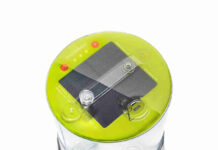
 Yen-Ting Kuo, a doctoral candidate in chemistry, Taiwan, has spent several years in K-State’s chemistry program working to create new materials that better use sunlight in chemical reaction processes to generate energy.
Yen-Ting Kuo, a doctoral candidate in chemistry, Taiwan, has spent several years in K-State’s chemistry program working to create new materials that better use sunlight in chemical reaction processes to generate energy.
Alternative fuel sources for cars may have a glowing future as a Kansas State University graduate student is working to replace petroleum fuels with ones made from sunlight.
As a way to advance the clean fuel research, Kuo is making and studying metal-oxide catalysts that react with light. These catalysts, called photocatalysts, cause a chemical reaction when triggered by sunlight, but are not destroyed during the reaction. Photocatalysts are crucial to producing new fuels, like solar gasoline, which use hydrogen.
To make solar gasoline, sunlight is channeled into a tank of water that contains photocatalysts. The sunlight triggers the photocatalysts to react with the water. This reaction causes the water to split into hydrogen and oxygen. When the hydrogen is combined with carbon monoxide it forms a synthetic gas — called syngas — that is the basic building block in fossil fuel and can be used to power cars.
In recent years solar gasoline has been getting more mileage as more international laboratories attempt to improve and perfect the process. But developing a photocatalyst that efficiently uses sunlight to create a chemical reaction and produce hydrogen is proving difficult for researchers. It also is needed for production to reach commercial levels. Kuo is working to solve that problem by creating and analyzing new photocatalysts in the lab.
To make a photocatalyst, Kuo mixes various elements in powdered form, and then cooks them at temperatures between 700 degrees Celsius and 850 degrees Celsius.
Once the material is made, its structure is studied with a transmission electron microscope and ultraviolet spectrums. Doing this allows Kuo to look at ways to structurally improve the photocatalyst and its performance.
In addition to improving the material’s photocatalytic properties — which will intensify reaction with the sunlight — Kuo focuses on increasing the material’s surface area. An increased surface area means bigger and better reactions, and a material with a high surface area and with high photocatalytic properties could mean a bright future for solar gasoline and other alternative fuels.
Engineering a photocatalyst that efficiently splits water into hydrogen and oxygen could also be a boon to fuel cell technology, Kuo said. Fuel cells operate by essentially reversing the chemical reaction that’s used to split water. Hydrogen is converted into electrical power, and water is given off as a byproduct.
“Even though the mature technology of fuel cells is in the near future, the source of hydrogen is still a question since most of the hydrogen sources now are from petroleum,” Kuo said. “Therefore, water splitting using photocatalysts is one of the solutions providing a new pathway to obtain hydrogen.”



